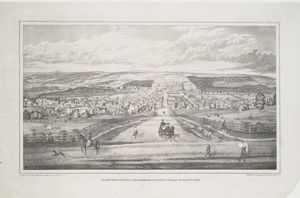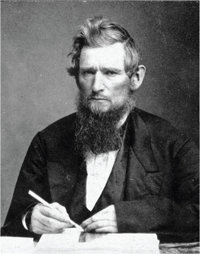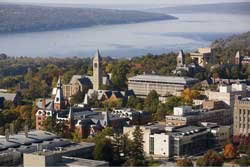
courtesy of www.nypl.org
In 1823 the county grew in size with the addition of the towns Caroline, Danby and Cayuta, which became Newfield, all originally from the Watkins and Flint Purchase and formerly within Tioga County. Further adjustments were made when Covert was returned to Seneca County, and again in 1853 when a portion of Newfield and the town of Hector became part of Schuyler County. From that time on, the county’s footprint has remained unaltered.
Early settlers were predominantly native-born farmers seeking new land. Some from eastern New York and the south brought slaves with them and until the abolition of slavery in New York, in 1827, there were both enslaved and free African Americans within the county, although their numbers were small. In the 1820 federal census claimed 72 non-whites and 20,609 white residents. There were also 20 foreign-born aliens. At that time neither Danby nor Caroline (where the largest number of slaves were held) were located in Tompkins County.

Population in Tompkins County rose gradually over the course of the nineteenth century and into the mid-twentieth. A close look at those figures, however, shows that while the Village of Ithaca increased steadily in population, most of the towns of the county reached a peak population before mid-century and then dipped to half that level in the early years of the twentieth century. In 1827, the Rev. J. Perkins wrote that people were moving out of the area while others were moving in. “This is the most fluctuating place I was ever in,” he commented. The town of Newfield declined in population from a high in 1850 of 3,816 residents to a 1910 low of 1,509, and even towns on somewhat better land experienced a dip. Lansing, with over 4,000 residents in 1830, had but 2,676 in 1910; Dryden peaked in 1840 with 5,446 but slipped to 3,590 in 1910. Some of this decline can be attributed to the type of land available for farms, but there was also a strong draw on restless people to the West, and to more urban areas.

courtesy of www.wikipedia.org
During the early nineteenth century there were a number of small manufacturing companies, including a significant printing industry, a coverlet factory, and mills using the ample waterpower of Fall, Cascadilla, and Six Mile creeks. The opening of the Erie Canal in 1825 and the Seneca Canal connection to it, kept local goods flowing into the eastern markets but they competed with cheaper grains and produce from the Midwest where the flat land produced more per acre and thus could be sold for less.
A few county businesses flourished until the aftermath of the Depression of 1837 when the local economy slowed. There was a development attempt in 1840 to attract industry into the county but it failed. This had involved a group of civic-minded men who sent young Ezra Cornell to the east to seek industries. He was unsuccessful in his attempt to lure established factories to Ithaca.
The people of the county were of a variety of political opinions. Some, but not a majority, were abolitionists who supported a variety of answers to the problem of slavery. A few were involved with the effort to aid the fugitives from southern slavery. In the election of 1860, the voters of Tompkins County supported Abraham Lincoln, even while the village of Ithaca voted the Democratic ticket. When the Civil War began, the residents of the county responded with enthusiasm although their high spirits lagged as the toll of war became known and finding volunteers became more and more difficult. Army recruiters sought African American men to serve in the federal United States Colored Infantry in 1863 and at least two-dozen men from the county enlisted at that time.

It was the establishment of Cornell University in 1865 that stabilized the economy of the Tompkins County. The Morrill Land Grant Act of 1862 provided land to states for the support of agricultural and mechanical education, and training in military tactics. It was through his interest in agricultural education and providing education for boys from poor families—reflecting his own background--that Ezra Cornell staked his own newly–made fortune and his Ithaca farm to bring the Morrill Land Grant College in Tompkins County. But Cornell knew little of universities. The school that emerged was the product of the experience and ideas of Andrew Dickson White, who had been born in Homer, grown up in Syracuse, and who had been educated at Hobart and William Smith College, Yale University, and in Europe. Together the two men founded Cornell University attracting students, faculty, and many new residents to the county. Some families even moved to Ithaca while their children attended the university.
